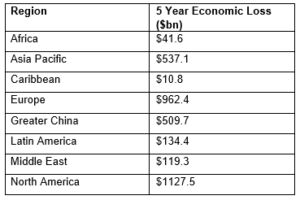A cyber attack on a major financial services payments system could result in widespread business disruptions, potentially costing the global economy $3.5 trillion over a five-year period, according to research from Lloyd’s and the Cambridge Centre for Risk Studies.
While the cyber insurance market is growing, it still is a relatively immature market, estimated at around $9.2 billion in gross written premiums in 2022 and forecast to reach between $13 billion and $25 billion by 2025. As a result, Lloyd’s said, it would cover only a small portion of the potential economic losses faced by businesses and society.
The three countries that would experience the highest five-year economic loss from the scenario are the United States at $1.1 trillion, followed by China at $470 billion and Japan $200 billion, Lloyd’s said, noting that the recovery time for individual countries or regions depends on the structure of their economy, exposure levels and resilience.

“We are committed to building resilience around systemic risk and the risk scenario released today highlights the important role of insurance in supporting and protecting customers against the potential threat cyber poses to businesses and society,” commented Lloyd’s Chairman Bruce Carnegie-Brown, in a statement.
“The global interconnectedness of cyber means it is too substantial a risk for one sector to face alone, and, therefore, we must continue to share knowledge, expertise and innovative ideas across government, industry and the insurance market to ensure we build society’s resilience against the potential scale of this risk,” he added.
More than a fifth of the world’s cyber premium is placed in the Lloyd’s market. “In time, greater penetration of cyber insurance should create a virtuous circle. As underwriters gather more data on cyber risk, they will be able to develop more relevant and more attractive products for customers, driving higher demand,” Lloyd’s said.
The research explores nine hypothetical (but plausible) systemic risk scenarios and is complimented by an interactive data tool that allows users to reveal the potential economic impact of each scenario across 107 countries and at three levels of severity (major, severe and extreme). The global economic loss ranges from £2.2 trillion in the lowest severity scenario up to $16 trillion in the most extreme scenario.
The scenario severities have been given a probability of occurring in the next five years, based on several risk factors. In the cyber scenario, the probabilities for each severity are: major 3.32 percent (1 in 30-year), severe 0.50 percent(1 in 200-year), extreme 0.12 percent (1 in 1,000 year).
Lloyd’s defined “systemic risk” as a low likelihood, high impact risk which affects either a systemically important global enterprise or multiple sectors, societies, or national economies. They can be global in impact, often hitting billions of people simultaneously.
This article was previously published by Insurance Journal. Reporter L.S. Howard is the International Editor of Carrier Management and Insurance Journal.





















 Executives on the Move at Liberty Mutual, Cowbell, W. R. Berkley
Executives on the Move at Liberty Mutual, Cowbell, W. R. Berkley  Federal Aviation Notice Warned of Slackline Before Deadly Arizona Helicopter Crash
Federal Aviation Notice Warned of Slackline Before Deadly Arizona Helicopter Crash  Breaking: Andersen to Replace Zaffino as CEO of AIG on June 1
Breaking: Andersen to Replace Zaffino as CEO of AIG on June 1  Expense Ratio Analysis: AI, Remote Work Drive Better P/C Insurer Results
Expense Ratio Analysis: AI, Remote Work Drive Better P/C Insurer Results 